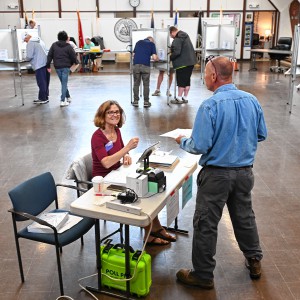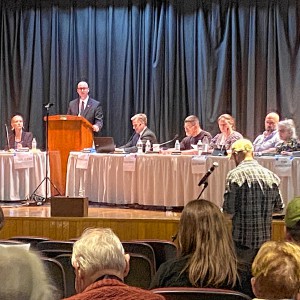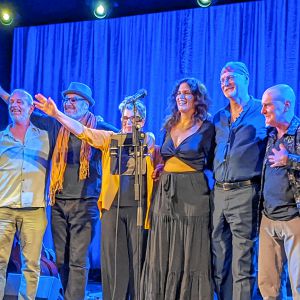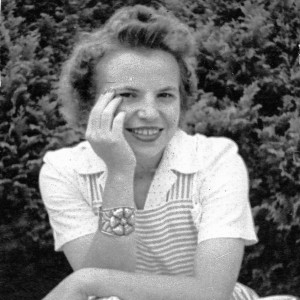Triumph, tragedy of Paul Goesch on display at Clark Art Institute
| Published: 05-19-2023 2:38 PM |
He was the German architect who never built, yet his designs have been influential for generations. Even when shut off from society for almost half his life, he continued to paint and draw, producing some 2,000 images. Although at one time German art galleries may have shown his paintings alongside the works of Picasso, Klee and Kandinsky, today he remains unknown to many art historians. Now, through June 11, you can view the first American exhibit of Paul Goesch (1885 – 1940) at Williamstown’s Clark Art Institute.
“He was really central to the most progressive movement in 20th century architecture,” Rob Wiesenberger said during a walk through the three-gallery exhibit. He‘s the Clark’s curator of contemporary projects and co-author of the exhibit’s companion catalogue, “Portals” (Yale University Press). “He’s hugely significant,” the curator continued, “and I find the work super interesting.”
Goesch was born in northern Germany, to a well-to-do family, his father a district court lawyer. In his late teens he began the study of architecture and engineering, touring Europe in his spare time. In his late 20s he converted to Catholicism and took on a lifetime study of Buddhism and various forms of self-enlightenment. At age 24, however, he suffered from hallucinations and was hospitalized for a year.
During World War I, Goesch was employed as chief state architect in what is now Chelmno, Poland. During this period he began a series of fantastical architectural drawings.
“He was capable,” Wiesenberger said. “He could draw a perfectly correct architectural plan – that’s just not what interested him very much.” A frequent image is that of a portal, an entryway, and as the curator noted, there are myriad compositions of “doors and passageways and archways and facades.” For Goesch, their creation had religious symbolism, as entrances away from the profane and into the sacred.
In his late 30s, diagnosed with schizophrenia, he would spend the rest of his life, with brief interludes of freedom, inside an institution. He would meet with a horrible fate.
There are many “outside ” artists, often untrained, who add spice and color to the world of images. Henry Darger was a reclusive custodian working at a Chicago hospital. When he passed away in 1973, he left behind a 15,145-page illustrated epic. Images from that story now command high prices. The self-taught Nova Scotian artist Maud Lewis sold her cheery paintings for five or ten dollars. In the last years of her life she was “discovered” and two images were later purchased by the Nixon White House. Recently one of her oils sold for $350,000. Wiesenberger was asked whether Goesch was in that category.
“That’s the whole show,” he said. “He’s an insider because he studied architecture and he’s a member of avant-garde groups… but by being institutionalized for most of his life… he’s considered an outsider.”
Article continues after...
Yesterday's Most Read Articles
 Political newcomer defeats Shores Ness for Deerfield Selectboard seat
Political newcomer defeats Shores Ness for Deerfield Selectboard seat
 South County Senior Center opts not to renew church lease after rift over LGBTQ program
South County Senior Center opts not to renew church lease after rift over LGBTQ program
 More than 130 arrested at pro-Palestinian protest at UMass
More than 130 arrested at pro-Palestinian protest at UMass
 As I See It: Between Israel and Palestine: Which side should we be on, and why?
As I See It: Between Israel and Palestine: Which side should we be on, and why?
 Moratoriums on large-scale solar, battery storage passed in Northfield
Moratoriums on large-scale solar, battery storage passed in Northfield
 Bridge of Flowers in Shelburne Falls to open on plant sale day, May 11
Bridge of Flowers in Shelburne Falls to open on plant sale day, May 11
The show captures a brief period of Goesch’s productive life, a halcyon period from 1920 to 1921, when he was very much in the center of a Renaissance in German arts and culture. It was a heady time since the country, during the Weimar Republic, had its first democracy.
“It’s a time when artists and architects are dreaming of a new future, distant from the broken old order,” Wiesenberger said.
Germany itself was severely fractured, having lost almost three million soldiers and civilians in the ravages of World War I. The Versailles Treaty took away more than 10 per cent of its territories, the same percentage of its coal production and almost half of its iron works.
There was a scarcity of post-war material goods and this gave birth to “paper architecture,” wherein designers, bereft of glass, steel and concrete, simply imagined a future utopia.
An amalgam of architects maintained a lively correspondence through writings in “The Glass Chain.” The author and architect Bruno Taut was the ringleader of this group to which Goesch belonged. Taut was also associated with Walter Gropius who, in 1919 created “The Bauhaus.” It was a pioneering modernist institution and many of its designs are still manufactured today.
Coincidentally, his Cambridge firm designed the Clark’s Manton Research Center, where this exhibit now resides.
Taut published an architectural journal, “Morning Light,” and often featured Goesch’s drawings.
“Taut thought the world of Paul Goesch and really reproduced his work more than anyone else,” Wiesenberger said.
What appears to be key to his drawings is, at times, the dramatic use of color and designs that are entirely removed from the neoclassical, cookie-cutter styles of early 20th century buildings.
“This is absolutely unbounded creativity,” Wiesenberger said. As to Goesch’s personality, Wiesenberger said that “he was really a recluse and socially not well-adjusted. He was very kind and very warm and had such openness to the world.”
Goesch’s prolific work ranged from surreal portraits to abstractions of designs, often intricate mandalas of claustrophobic intensity that can be unsettling. Schizophrenia has been referred to as “the illness of the lights” wherein the afflicted sees halations or auras surrounding objects.
“One shouldn’t mythologize his work,” the curator cautioned, “or read his mental state into it.” The drawings shown here were created during a time when he wasn’t institutionalized.
By his late 30s, Goesch was in psychiatric care for the rest of his life. Fortunately, his brother-in-law was the director of a Gottingen clinic and the architect received sympathetic treatment there. He continued to create drawings and watercolors on every piece of paper he could find and even compulsively drew on the backings of other paintings. While in Gottingen he created a huge mural in his room that can still be seen.
In 1934, with the Nazis now in power, he was taken from the clinic and forced into hard labor. Five years later under the Nazi’s “Aktion T4” program, a mass extermination of physically and mentally infirm people began. Estimates are that as many as 300,000 people lost their lives in this genocide. Goesch was gassed to death at the Brandenburg jail in August of 1940.
Speaking to his body of work, Wiesenberger said, “In some ways he’s anticipating the future in which architecture is limited only by the imagination. Adults and children will get something out of it. It’s evocative and it’s fun.”
The work of Maine sculptress and photographer Elizabeth Atterbury can be found a few paces from the Goesch exhibit as well as on the walls of the Clark Center café.
“In the last few years I have been appropriating and remaking forms that are from my own world,” she said in a recent online video. She is prolific in enlarging everyday objects ranging from clothespin springs to oversized peanuts. In the video you see abstract wooden forms, almost familiar to the eye, that may remind you of the curiously named “found things” of New Yorker cartoonist Roz Chast.
In Atterbury’s exhibit you’ll find a fan of cherry wood, some seven feet in width, while a nearby ink stamp of stone is equally outsized and seems immovable at well over 100 pounds.
Of Chinese lineage, she works in a variety of mediums, among them chine colle. This is a printing process wherein delicate tissue or linen holds an image that is supported by a stronger material beneath. There are also large abstractions in tile mortar, which require a complex series of imprinting shapes and is reminiscent of sand painting. Atterbury, who has exhibited widely in the States, titled the display “Oracle Bones.” This refers to the discovery by one of her long ago relatives. He determined that the markings on ancient invertebrate animal bones dating to the Shang Dynasty were the first forms of Chinese writing. The bones were used in pyromancy, the use of fire to determine the future.
“Portals: The Visionary Architecture of Paul Goesch” continues through June 11. “Oracle Bones” continues through January 21. The institute is open from Tuesday through Sunday, 10 a.m. to 5 p.m, and open daily July through August. Admission is $20 or free for under 21 and students with a student ID.

 Sounds Local: Joni Mitchell tribute comes to Turners Falls: Big Yellow Taxi to perform ‘Court and Spark’ in its entirety, May 18 at the Shea
Sounds Local: Joni Mitchell tribute comes to Turners Falls: Big Yellow Taxi to perform ‘Court and Spark’ in its entirety, May 18 at the Shea On Mother’s Day, we’ll always have Paris: A crêpe recipe in honor of my French-speaking mother
On Mother’s Day, we’ll always have Paris: A crêpe recipe in honor of my French-speaking mother Providing opportunity for people to grow: The United Arc of Franklin County’s annual Gardening with Steve event a highlight of spring
Providing opportunity for people to grow: The United Arc of Franklin County’s annual Gardening with Steve event a highlight of spring Speaking of Nature: Capturing my Bermuda nemesis: The Great Kiskadee nearly evaded me, until I followed its song
Speaking of Nature: Capturing my Bermuda nemesis: The Great Kiskadee nearly evaded me, until I followed its song
